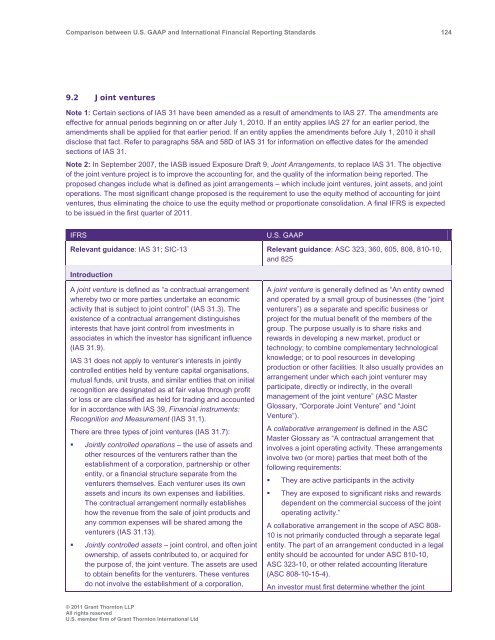Comparison between U.S. GAAP and International ... - Grant Thornton
Comparison between U.S. GAAP and International ... - Grant Thornton
Comparison between U.S. GAAP and International ... - Grant Thornton
You also want an ePaper? Increase the reach of your titles
YUMPU automatically turns print PDFs into web optimized ePapers that Google loves.
<strong>Comparison</strong> <strong>between</strong> U.S. <strong>GAAP</strong> <strong>and</strong> <strong>International</strong> Financial Reporting St<strong>and</strong>ards 124<br />
9.2 Joint ventures<br />
Note 1: Certain sections of IAS 31 have been amended as a result of amendments to IAS 27. The amendments are<br />
effective for annual periods beginning on or after July 1, 2010. If an entity applies IAS 27 for an earlier period, the<br />
amendments shall be applied for that earlier period. If an entity applies the amendments before July 1, 2010 it shall<br />
disclose that fact. Refer to paragraphs 58A <strong>and</strong> 58D of IAS 31 for information on effective dates for the amended<br />
sections of IAS 31.<br />
Note 2: In September 2007, the IASB issued Exposure Draft 9, Joint Arrangements, to replace IAS 31. The objective<br />
of the joint venture project is to improve the accounting for, <strong>and</strong> the quality of the information being reported. The<br />
proposed changes include what is defined as joint arrangements – which include joint ventures, joint assets, <strong>and</strong> joint<br />
operations. The most significant change proposed is the requirement to use the equity method of accounting for joint<br />
ventures, thus eliminating the choice to use the equity method or proportionate consolidation. A final IFRS is expected<br />
to be issued in the first quarter of 2011.<br />
IFRS<br />
U.S. <strong>GAAP</strong><br />
Relevant guidance: IAS 31; SIC-13 Relevant guidance: ASC 323, 360, 605, 808, 810-10,<br />
<strong>and</strong> 825<br />
Introduction<br />
A joint venture is defined as “a contractual arrangement<br />
whereby two or more parties undertake an economic<br />
activity that is subject to joint control” (IAS 31.3). The<br />
existence of a contractual arrangement distinguishes<br />
interests that have joint control from investments in<br />
associates in which the investor has significant influence<br />
(IAS 31.9).<br />
IAS 31 does not apply to venturer’s interests in jointly<br />
controlled entities held by venture capital organisations,<br />
mutual funds, unit trusts, <strong>and</strong> similar entities that on initial<br />
recognition are designated as at fair value through profit<br />
or loss or are classified as held for trading <strong>and</strong> accounted<br />
for in accordance with IAS 39, Financial instruments:<br />
Recognition <strong>and</strong> Measurement (IAS 31.1).<br />
There are three types of joint ventures (IAS 31.7):<br />
• Jointly controlled operations – the use of assets <strong>and</strong><br />
other resources of the venturers rather than the<br />
establishment of a corporation, partnership or other<br />
entity, or a financial structure separate from the<br />
venturers themselves. Each venturer uses its own<br />
assets <strong>and</strong> incurs its own expenses <strong>and</strong> liabilities.<br />
The contractual arrangement normally establishes<br />
how the revenue from the sale of joint products <strong>and</strong><br />
any common expenses will be shared among the<br />
venturers (IAS 31.13).<br />
• Jointly controlled assets – joint control, <strong>and</strong> often joint<br />
ownership, of assets contributed to, or acquired for<br />
the purpose of, the joint venture. The assets are used<br />
to obtain benefits for the venturers. These ventures<br />
do not involve the establishment of a corporation,<br />
A joint venture is generally defined as “An entity owned<br />
<strong>and</strong> operated by a small group of businesses (the “joint<br />
venturers”) as a separate <strong>and</strong> specific business or<br />
project for the mutual benefit of the members of the<br />
group. The purpose usually is to share risks <strong>and</strong><br />
rewards in developing a new market, product or<br />
technology; to combine complementary technological<br />
knowledge; or to pool resources in developing<br />
production or other facilities. It also usually provides an<br />
arrangement under which each joint venturer may<br />
participate, directly or indirectly, in the overall<br />
management of the joint venture” (ASC Master<br />
Glossary, “Corporate Joint Venture” <strong>and</strong> “Joint<br />
Venture”).<br />
A collaborative arrangement is defined in the ASC<br />
Master Glossary as “A contractual arrangement that<br />
involves a joint operating activity. These arrangements<br />
involve two (or more) parties that meet both of the<br />
following requirements:<br />
• They are active participants in the activity<br />
• They are exposed to significant risks <strong>and</strong> rewards<br />
dependent on the commercial success of the joint<br />
operating activity.”<br />
A collaborative arrangement in the scope of ASC 808-<br />
10 is not primarily conducted through a separate legal<br />
entity. The part of an arrangement conducted in a legal<br />
entity should be accounted for under ASC 810-10,<br />
ASC 323-10, or other related accounting literature<br />
(ASC 808-10-15-4).<br />
An investor must first determine whether the joint<br />
© 2011 <strong>Grant</strong> <strong>Thornton</strong> LLP<br />
All rights reserved<br />
U.S. member firm of <strong>Grant</strong> <strong>Thornton</strong> <strong>International</strong> Ltd
















